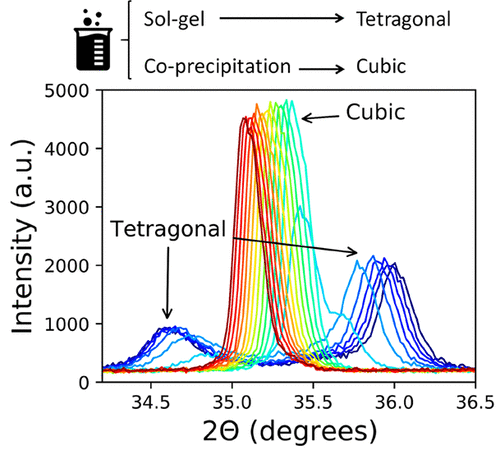当前位置:
X-MOL 学术
›
Inorg. Chem.
›
论文详情
Our official English website, www.x-mol.net, welcomes your
feedback! (Note: you will need to create a separate account there.)
Influence of the Synthesis Route in Obtaining the Cubic or Tetragonal Copper Ferrite Phases.
Inorganic Chemistry ( IF 4.3 ) Pub Date : 2020-06-18 , DOI: 10.1021/acs.inorgchem.0c00416 Jaume Calvo-de la Rosa 1 , Mercè Segarra Rubí 1
Inorganic Chemistry ( IF 4.3 ) Pub Date : 2020-06-18 , DOI: 10.1021/acs.inorgchem.0c00416 Jaume Calvo-de la Rosa 1 , Mercè Segarra Rubí 1
Affiliation

|
In this work, magnetic copper ferrite nanoparticles are synthesized by polymer-assisted sol–gel and coprecipitation methods. The obtained purity and particle size reach values of 96% and 94 nm, respectively. Evident differences in the crystal structure have been found in the synthesized nanoparticles. A tetragonal structure is formed by the sol–gel method, while the cubic form is obtained when the coprecipitation approach is used. This work provides experimental evidence of the formation of both phases by using the same reactants and thermal conditions and only modifying the technical procedure. The formation and stability of each phase are analyzed by temperature-dependent measurements, and the observed crystal structure differences are used to propose a potential fundamental explanation to our observations based on differences in the cations’ distribution and Jahn–Teller distortion. Moreover, different copper ferrite purities and particle sizes are found when using each of the methods. The spherical shape of the particles and their tendency to sinter, forming micrometric clusters, are observed by electron microscopy. Finally, the divergence in magnetization between the samples prepared by each method supports our argument about the different cations’ distribution and opens the door to a wide range of different technological applications for these materials.
中文翻译:

合成路线对获得立方或四方铜铁氧体相的影响。
在这项工作中,磁性铜铁氧体纳米粒子是通过聚合物辅助的溶胶-凝胶法和共沉淀法合成的。获得的纯度和粒径分别达到96%和94nm的值。在合成的纳米颗粒中已经发现晶体结构的明显差异。溶胶-凝胶法形成四方结构,而使用共沉淀法则获得立方结构。这项工作通过使用相同的反应物和热条件并仅修改技术程序,为形成两相提供了实验证据。通过与温度有关的测量来分析每个相的形成和稳定性,所观察到的晶体结构差异可根据阳离子分布和Jahn-Teller畸变的差异为我们的观察结果提供潜在的基本解释。此外,使用每种方法时,会发现不同的铁氧体铜纯度和粒径。通过电子显微镜观察到颗粒的球形和它们的烧结趋势,形成微米簇。最后,每种方法制备的样品之间的磁化强度差异支持了我们对不同阳离子分布的争论,并为这些材料的广泛不同技术应用打开了大门。通过电子显微镜观察到颗粒的球形形状及其烧结趋势,形成微米级团簇。最后,每种方法制备的样品之间的磁化强度差异支持了我们对不同阳离子分布的争论,并为这些材料的广泛不同技术应用打开了大门。通过电子显微镜观察到颗粒的球形形状及其烧结趋势,形成微米级团簇。最后,每种方法制备的样品之间的磁化强度差异支持了我们对不同阳离子分布的争论,并为这些材料的广泛不同技术应用打开了大门。
更新日期:2020-07-06
中文翻译:

合成路线对获得立方或四方铜铁氧体相的影响。
在这项工作中,磁性铜铁氧体纳米粒子是通过聚合物辅助的溶胶-凝胶法和共沉淀法合成的。获得的纯度和粒径分别达到96%和94nm的值。在合成的纳米颗粒中已经发现晶体结构的明显差异。溶胶-凝胶法形成四方结构,而使用共沉淀法则获得立方结构。这项工作通过使用相同的反应物和热条件并仅修改技术程序,为形成两相提供了实验证据。通过与温度有关的测量来分析每个相的形成和稳定性,所观察到的晶体结构差异可根据阳离子分布和Jahn-Teller畸变的差异为我们的观察结果提供潜在的基本解释。此外,使用每种方法时,会发现不同的铁氧体铜纯度和粒径。通过电子显微镜观察到颗粒的球形和它们的烧结趋势,形成微米簇。最后,每种方法制备的样品之间的磁化强度差异支持了我们对不同阳离子分布的争论,并为这些材料的广泛不同技术应用打开了大门。通过电子显微镜观察到颗粒的球形形状及其烧结趋势,形成微米级团簇。最后,每种方法制备的样品之间的磁化强度差异支持了我们对不同阳离子分布的争论,并为这些材料的广泛不同技术应用打开了大门。通过电子显微镜观察到颗粒的球形形状及其烧结趋势,形成微米级团簇。最后,每种方法制备的样品之间的磁化强度差异支持了我们对不同阳离子分布的争论,并为这些材料的广泛不同技术应用打开了大门。











































 京公网安备 11010802027423号
京公网安备 11010802027423号